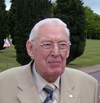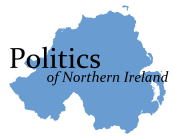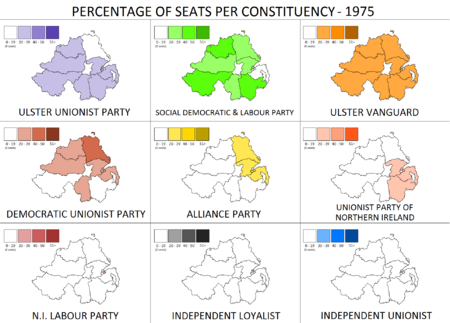- Northern Ireland Constitutional Convention
-
Northern Ireland Constitutional Convention 
1973 ←
members1 May 1975 → 1982
membersAll 78 seats to the Northern Ireland Constitutional Convention
40 seats were needed for a majorityFirst party Second party Third party 


Leader Harry West Gerry Fitt Ian Paisley Party Ulster Unionist SDLP Democratic Unionist Leader since 22 January 1974 21 August 1970 30 September 1971 Leader's seat Fermanagh and South Tyrone Belfast North North Antrim Last election 31 seats (35.8%) 19 seats (22.1%) 8 seats (10.8%) Seats won 19 17 12 Seat change  12
12 2
2 4
4Popular vote 167,214 156,049 97,073 Percentage 25.4% 23.7% 14.8% Swing  10.4%
10.4% 1.6%
1.6% 4.5%
4.5%Fourth party Fifth party Sixth party 


Leader William Craig Oliver Napier Brian Faulkner Party Vanguard Alliance Unionist Party NI Leader since 9 February 1972 1972 4 September 1974 Leader's seat Belfast East Belfast East South Down Last election 7 seats (11.5%) 8 seats (9.2%) N/A Seats won 14 8 5 Seat change  7
7 0
0 5
5Popular vote 83,507 64,657 50,891 Percentage 12.7% 9.8% 7.7% Swing  1.2%
1.2% 0.5%
0.5% 7.7%
7.7%
Percentage of seats gained by each of the party.
Chief Executive before election
Elected Chief Executive
None
Northern Ireland 1973–98 
This article is part of the series:
Politics and government of
Northern IrelandInterim bodies Northern Ireland Assembly (1973)
Northern Ireland Executive (1974)
Constitutional Convention (1975)
Northern Ireland Assembly (1982)
Northern Ireland Forum (1996)Elections 1973 · 1975 · 1982 · 1996 Members 1973 · 1975 · 1982 · 1996 See also Anglo-Irish Agreement
New Ireland Forum
Northern Ireland by-elections, 1986
Northern Ireland sovereignty referendum, 1973
The Northern Ireland Constitutional Convention (NICC) was an elected body set up in 1975 by the UK Labour government of Harold Wilson as an attempt to deal with constitutional issues surrounding the status of Northern Ireland.
Contents
Formation of the Constitutional Convention
The idea for a constitutional convention was first mooted by the Northern Ireland Office in its white paper The Northern Ireland Constitution, published on 4 July 1974.[1] The paper laid out plans for elections to a body which would seek agreement on a political settlement for Northern Ireland. The proposals became law with the enactment of the Northern Ireland Act 1974 later that month. With Lord Chief Justice Robert Lowry appointed to chair the new body, elections were announced for 1 May 1975.
The elections were held for the 78-member body using the Single Transferable Vote system of proportional representation in each of Northern Ireland's twelve Westminster constituencies. Initially the body was intended to be purely consultative, although it was hoped that executive and legislative functions could be devolved to the NICC once a cross-community agreement had been reached.
Results
Unionists opposed to the NICC once again banded together under the umbrella of the United Ulster Unionist Council (UUUC) and this coalition proved the most successful, taking 46 seats.
Party Leader Votes % Seats +/- Ulster Unionist (UUUC) Harry West 167,214 25.4 19 +10 SDLP Gerry Fitt 156,049 23.7 17 −2 Democratic Unionist (UUUC) Ian Paisley 97,073 14.8 12 +4 Vanguard (UUUC) William Craig 83,507 12.7 14 +7 Alliance Oliver Napier 64,657 9.8 8 0 Unionist Party NI Brian Faulkner 50,891 7.7 5 −19 Republican Clubs Tomás Mac Giolla 14,515 2.2 0 0 Labour (NI) David Bleakley 9,102 1.4 1 0 Independent Loyalist (UUUC) N/A 5,687 0.9 1 +1 Independent Unionist N/A 4,453 0.6 1 −2 Ulster Unionist Party (non-UUUC) Harry West 2,583 0.4 0 N/A Independent N/A 2,052 0.3 0 0 Communist Party Michael O'Riordan 378 0.1 0 0 Source: Northern Ireland Constitutional Convention Elections 1975
Votes summary
Seats summary
Leading Members
A number of leading Northern Ireland politicians were elected to the NICC, increasing hope that the body might achieve some of its aims. Also elected were a number of younger figures who would go on to become leading figures in the future of Northern Ireland politics. These included:
- Glenn Barr - VPUP
- Lord Brookeborough - UPNI
- William Craig - VPUP
- Austin Currie - SDLP
- Reg Empey - VPUP
- Brian Faulkner - UPNI
- Gerry Fitt - SDLP
- John Hume - SDLP
- James Kilfedder - UUP
- Seamus Mallon - SDLP
- Oliver Napier - APNI
- Ian Paisley - DUP
- Martin Smyth - UUP
- John Taylor - UUP
- David Trimble - VPUP
- Harry West - UUP
Progress of the NICC
The elections left the body fundamentally weakened from its inception as an overall majority had been obtained by those Unionists who opposed power sharing as a concept. As a result the Northern Ireland Constitutional Convention Report published on 20 November 1975[2] recommended only a return to majority rule as had previously existed under the old Parliament of Northern Ireland government. As such a solution was completely unacceptable to the nationalist parties, the NICC was placed on hiatus.
Hoping to gain something from the exercise, Secretary of State for Northern Ireland Merlyn Rees announced that the NICC would be reconvened on 3 February 1976. However, a series of meetings held between the UUUC and the SDLP failed to reach any agreement about SDLP participation in government, and so the reconvened NICC once again failed to achieve a solution with cross-community support. As a result, Rees announced the dissolution of the body on 4 March 1976 and Northern Ireland remained under direct rule.
Significance of the NICC
On the face of it, the NICC was a total failure as it did not achieve its aims of agreement between the two sides or of introducing 'rolling devolution' (gradual introduction of devolution as and when the parties involved saw fit to accept it). Nevertheless, coming as it did not long after the Conservative-sponsored Sunningdale Agreement, the NICC indicated that no British government would be prepared to re-introduce majority rule in Northern Ireland. During the debates William Craig accepted the possibility of power-sharing with the SDLP, a move that split the UUUC and precipitated the eventual collapse of Vanguard.
The idea of electing a consultative body to thrash out a deal for devolution was also retained and in 1996 it was revived when the Northern Ireland Forum was elected on largely the same lines and with the same overall purpose. Given that the Forum led to the Belfast Agreement and the Northern Ireland Assembly, the importance of the NICC as a model for this second body is clear.
References
External links
Elections and referendums in Northern Ireland Elections Local government elections 1973 · 1977 · 1981 · 1985 · 1989 · 1993 · 1997 · 2001 · 2005 · 2011Referendums Categories:- Government of Northern Ireland
- History of Northern Ireland
- Elections in Northern Ireland
- United Kingdom constitution
- Home rule in the United Kingdom
- Constitutional conventions
- 1975 in Northern Ireland
Wikimedia Foundation. 2010.

